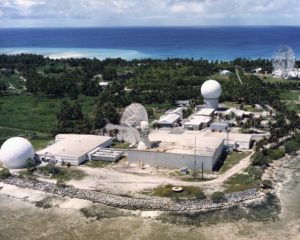U.S. Indo-Pacific Command’s (INDOPACOM) $11 billion unfunded priorities list for fiscal year 2025 seeks an additional $430 million for the Guam defense systems and $1.4 billion for classified space programs, according to a copy of the document obtained by Defense Daily.
The list, submitted to Congress for consideration following the FY ‘25 budget rollout, includes requests for an additional $2.7 billion for procurement, $2 billion for research and development efforts, $3.4 billion for military construction projects, $1.3 billion for operations and maintenance items and $1.7 billion for classified items.

The $430.1 million for defense of Guam items on the list includes $181.3 million for R&D efforts, $248 million for military construction and $800,000 for procurement.
INDOPACOM notes the request would fund resources for the continued development of a “Missile Defense System for the defense of Guam against ballistic, hypersonic, and cruise missile threats.”
The Missile Defense Agency’s $10.4 billion FY ‘25 budget request included $1.2 billion for its continue work on Defense of Guam programs, to include development and procurement of the Aegis Guam System and Vertical Launch Systems, completing environmental impact studies, starting construction of a command center complex to support Guam missile defense command and control components, a Transportable Array Unit complex and launcher field complex (Defense Daily, March 14).
The $1.4 billion on the list for classified space programs includes $701 million for accelerating development of space-based persistent custody sensors to “provide persistent and complete coverage of air, sea, and ground-launched missile threats” and $701 million for “space control and enabling capabilities.”
The list also includes $122.7 million for further development of a Joint Fires Network, specifically a battle management system “to display real-time, actionable threat tracks shareable across the joint and coalition forces and fusion centers, with the ability to place those tracks at risk” as well as $124 million for an INDOPACOM mission network “to securely communicate, collaborate, plan and execute actions with allies and partners.”
INDOPACOM also seeks additional funds for a range of munitions, to include over $1 billion related to Maritime Strike Tomahawk efforts, $766.9 million in Navy procurement for SM-6 Block IB missiles, $390.7 million for the Army’s Precision Strike Missile program, $298.5 million in Air Force procurement for Joint Strike Missiles and $105.1 million for Long-Range Anti-Ship Missiles.
For mine-related efforts, the combatant command is seeking $125 million for the Navy’s Powered Quickstrike program, “a family of shallow water, aircraft laid mines used against surface and subsurface targets,” as well as $74.6 million for Clandestine Delivered Mines and $396.9 million for Hammerhead mines, which it described as a “moored-torpedo variant mine system designed to be delivered by unmanned underwater vehicles and surface vessels.”
The list also includes $580.7 million to support service component campaigning efforts in the Indo-Pacific, covering resourcing “to conduct and sequence logically-linked military initiatives aimed at advancing well-defined, strategy-aligned priorities over time.”